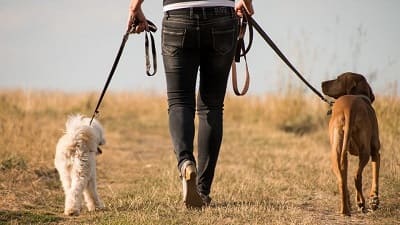Tips for Walking a Dog
Tips for Walking a Dog
Teaching your dog to walk is very simple if you know how to do it. Surely you have seen dozens of dogs walking along the street with their owners, many of them walk correctly and some others…. walking very, very bad.
Pasear con un perro que no sabe pasear, puede ser un incordio; tirones, adelantamientos, tensión en la correa y un sin fin de problemas que pueden convertir un bonito paseo en toda una odisea. Así que vamos a explicar cómo debes enseñar a pasear correctamente a tu perro ¿Empezamos?.

Educate him from the beginning
Whether your dog is an adult or a puppy, you should teach him to walk with you. Dogs do not know if they do it badly or well, they simply walk and it is their owners who must tell them if they do it well or badly, correct them or congratulate them. Most dog walking behavior problems are due to poor communication between the owner and the dog, not a rude dog.
If your dog is a puppy you should vaccinate him before going out with him, get him used to wearing the collar all day. When he is a little older and is used to it, you can take it off at home or whenever you want … but as long as he is a puppy it is recommended that he always wear it, that he gets used to it and does not see it as a problem in his neck.
Let him use his energy
When a puppy or adult dog goes out into the street, the first thing he wants to do is run, play, urinate, greet other dogs…. This is something completely normal, that’s why when they leave home they are so energetic, full of vitality and with a lot of desire to play.
The first thing we must do before we start teaching our dog any task such as walking, lying down, bringing objects, etc … is to let it vent. By eliminating its extra energy we will have a dog much more submissive and willing to learn, therefore, the first thing we must do is let it release energy.

Choose an appropiate place
To teach our dog to walk, we must choose a quiet place, where it cannot be easily distracted and where it does not receive many stimuli (when it has learned the basics, we can practice in places with more stimuli).
A good place to go for a walk can be a park with little traffic, a country road, etc…. If our dog is learning in a place where he sees other dogs playing, screaming children, bouncing balls, etc … he will not learn anything, because he will be more attentive to those stimuli than to his owner.
Prepare the dog and prepare yourself
To start teaching our dog or puppy to walk, it is necessary to be completely relaxed. Humans transmit our problems indirectly to our dogs, so that if an owner is tense or stressed, the dog will notice that tension and will not be calm. To teach our dog to walk, we must be calm and in a good mood, unhurried and eager to teach.
Our dog or puppy must already be used to wearing a collar, so the only thing left for us … is to put a leash on it. It is very important to use a short leash to teach our dog to walk, the extendable leashes are not valid. A leash of one meter, more or less, is a good leash to teach our puppy or adult dog to walk with us.
Practical Tips
Perform the steps indicated as we have described them, make your dog vent and then start the classes. Never start a class with an energetic dog, it won’t do any good.
Avoid learning under the heat of the sun, try not to get too hot or your dog will only want to find a shade to take shelter.
Forget about choke / punishment collars, anti-pull leashes, etc… All dogs can learn with a normal collar and a medium size leash.
Your state of mind is essential, if you are not calm and with positive aptitude, do not teach the class.
If your dog is too upset, sit him down, lay him down, and massage him. Make him relax naturally and then the class begins.
Never let a small child from the classes for you, only the owner or an experienced adult (trainer), can teach the classes.
Have a bag of patience, some dogs take several months to learn to walk correctly, everything is a matter of practice and patience, there are no more tricks.
If the situation overcomes you, if you don’t have time … go to a professional, but always, always, you must be present at the training



